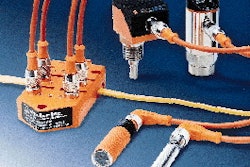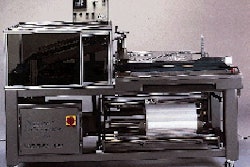Analog signal-Communicates information via a voltage or current level that varies within a predefined range in direct proportion to the intensity of the physical quantity, property or condition represented. Axes of motion-The number of motors in a packaging machine. Axes of motion can consist of separate (though related) movements, as in unwind reels or conveyor movement, or can be combined for a tightly coordinated movement, as on a robot. Bus-Refers to a type of circuit or protocol that serves as a common communications pathway shared by several components. For example, a device-level network is a type of bus that links a PLC to a packaging machine's sensors, actuators and other devices. Also see network and protocol. Deterministic scan time-The frequency with which a PLC executes a program, including scanning all the inputs and outputs on a packaging machine. Usually measured in milliseconds. A PLC might read a machine's sensors, make any necessary logic decisions and output signals to a packaging machine every 300 milliseconds. Device-level network-A means of putting sensors, actuators and other components on a common network cable that is connected to the PLC. Eliminates point-to-point wiring between the PLC and each device. Digital signal-One that communicates information in electrical pulses that represent binary 1s and 0s. It's widely believed that digital signals can transmit more information more reliably in a given unit of time than analog. Drive-An electronic device that translates a given command from a motion controller into the electrical power that turns a motor. Ethernet-An open networking standard, Ethernet is widely used in office automation and is increasingly being used for packaging machine networks. Originally developed for communications speed of 1.5 megabits/sec, newer versions permit speeds up to 100 megabits/sec. Hard, real-time control-Refers to the ability of a controller to respond to an event immediately, without delay. While PLCs are inherently designed for this, PCs can be trickier. To be a hard, real-time controller, a PC-based controller's software must be considered the highest priority task, and made independent of the rest of the PC. Human-machine interface-The console at which an operator or mechanic interacts with the controller of a packaging machine or line. An HMI, or MMI (man-machine interface) or OI (operator interface), often is a computer display with a PC or industrial computer built into or connected to run specialized HMI software. I/O-Input/output refers to electronic communications between a PLC and a packaging machine's sensors, actuators and other devices. Signals move on a bus or with dedicated, point-to-point wiring. Ladder logic-Traditional programming of PLCs, ladder logic is a symbol system that illustrates the functions of a control program. Power lines form the sides of the ladder-like structure, with the logic elements arranged to form the rungs. Can also be programmed via sequential function charts. Motion control network-Putting the drives and motion controller on a single cable instead of wiring each drive independently. Motion controller-An electronic device inside a packaging machine that communicates position, torque, acceleration, velocity, position and speed information to one or more drives. Network-Linking separate, individual devices or machines together so that one node can communicate with any other node. For example, several packaging machine PLCs can communicate over a PLC network. Conversely, one PLC can communicate with several sensors and actuators in a device-level network inside a packaging machine. A network eliminates the need for point-to-point wiring, but introduces the potential for delay due to communications traffic jams. Node-Any single device connected to a network is referred to as a node. For example, an operator interface PC might be a node on a PLC network, or a given sensor might be a node on a device-level network. Open standard-A standard type of hardware, software or communications protocol that's widely adopted by many suppliers. PC-Personal computer typically running under the Wintel standard. PC architecture can be adapted for packaging machine control through software. PLC-Programmable Logic Controller is a type of computer that provides hard, real-time control of packaging and other equipment thanks to fast, repeatable deterministic scan times. PLS-A Programmable Limit Switch is a dedicated, high-speed control that converts the rotary motion of a shaft into digital signals. PLSs are typically used to increase the accuracy of material or product positioning or registration. Point-to-point wiring-A method of wiring each component on a packaging machine directly to the PLC. Hard-wiring eliminates the potential for communication delays found on a network. Protocol-A particular method of encoding information-either analog or digital-for transmission over a cable. Often used interchangeably with standard. SCADA-Supervisory Control & Data Acquisition. Refers to software and hardware that (1) permits the control or management of an entire packaging line and (2) automatically collects data on that line's efficiency. SERCOS-SErial Real-time COmmunications Standard. An open communications protocol (adopted as IEC 1491) designed especially for motion-control networks. Defines a method for transmitting digital information over a fiber-optic cable at speeds of 2, and more recently, 4 megabits/sec. Serial communications-Transmitting digital 1s and 0s in a series over a single cable, the primary method of communication used in and between packaging equipment. Parallel communications use several wires to simultaneously transmit groups of 1s and 0s. Servo motor-A motor that together with its resolver or encoder is capable of being precisely controlled. A resolver or encoder provides constant and highly accurate feedback on the motor's exact position, speed and torque to the drive that powers it. TCP/IP-Transmission Control Protocol/Internet Protocol. A method of encoding data into a series of "packets" for transmission over a network. Designed initially for use on the Internet, TCP/IP is rapidly penetrating non-Internet uses, including the factory floor. Wintel-The defacto industry standard for PCs, referring to Microsoft's Windows(TM) operating system running on Intel's microprocessors. Packaging World thanks Electro Cam, Hershey Chocolate U.S.A., Indramat, Parker Hannifin, PLCopen and Steeplechase Software for their help.
Controls glossary for packagers
With the help of some readers, Packaging World has assembled a glossary that defines controls terms. Most important, these terms are defined in the context of packaging machinery so that virtually all readers can relate them to the machinery we're all familiar with.
May 31, 1998
Companies in this article
Machinery Basics
Annual Outlook Report: Automation & Robotics
What's in store for CPGs in 2025 and beyond? Packaging World editors explore the survey responses from 118 brand owners, CPG, and FMCG Packaging World readers for its new Annual Outlook Report.
Download
List: Digitalization Companies From PACK EXPO
Looking for CPG-focused digital transformation solutions? Download our editor-curated list from PACK EXPO featuring top companies offering warehouse management, ERP, digital twin, and MES software with supply chain visibility and analytics capabilities—all tailored specifically for CPG operations.
Download Now
Downloads






















